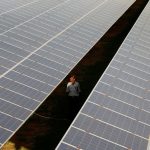When the forecast calls for record-breaking temperatures, the kind that turn the weather app warnings deep red and push the limits of what a window unit air conditioner can do, those in the know brace themselves.
Extreme heat means extreme electricity demand, and that can lead to rolling blackouts or outages that leave thousands without electricity.
But even amid record high temperatures, that has not been the story this week.
As the demand for electricity has soared, the regional power grid has hummed along uneventfully, backed in part by a relatively new source of energy: thousands of solar panels on rooftops, over parking lots, and along highways. It’s not just helping make the grid more reliable, experts said, but proving that non-fossil fuel generated power is finally playing a significant role in the operation of the regional power grid, with even more due to come online from major wind farms and other large-scale resources under development.
This particular subset of solar is known as “behind-the-meter” solar, and it is distinct from industrial-sized solar fields. It’s provided as much as one-fifth of the region’s power demand during the sunniest, hottest parts of the heat wave. For context, that’s more than all of the nuclear power being produced in New England during that time.
“Solar works best when people want electricity the most on the hottest days; that’s when the sun is out,” said Elena Weissmann, northeast director for Vote Solar, a nonprofit advocacy organization.
When something goes wrong and a power plant goes off line unexpectedly during a heat wave, as the recently shuttered Mystic Generating Station did in 2018, it can send costs soaring and force the grid operator, ISO-New England, to import power from surrounding regions and access emergency reserves.
But with thousands of small solar arrays distributed across the region, “if one of these solar arrays goes down, it’ll be immaterial,” said Joe LaRusso, manager of the Clean Grid Initiative at the Acadia Center.
Beyond the solar that helped power the grid through the heat wave, traditional resources, such as natural gas and nuclear power, held up reliably.
A small amount of oil-fired electricity was also powering the grid — an increasingly rare occurrence as the region weans itself off the dirtiest sources. But because oil power plants can take longer to fire up, keeping some operating at a low level during a heat wave is a precautionary measure, LaRusso said, so they can quickly ramp up if something goes wrong at another power plant or demand suddenly spikes.
Over the next decade ISO-New England estimates that the amount of solar on the grid will nearly double. That, along with the development of additional renewable resources such as wind and hydro-electric power, will further reduce dependence on fossil fuels when electricity demand spikes.
Matthew Kakley, spokesman for ISO-New England, said the role of behind-the-meter solar is vital to reliable operations. “Knowing these resources will provide electricity to homes and businesses around the region allows us to schedule less generation on the regional grid, while being prepared to handle any deviations from the forecast,” he said.
It’s also expected New England will experience more of what’s known as “duck curve” days, an indicator in the energy industry that refers to days in which solar provides so much energy that the supply of electricity needed from other sources dips lower during the daytime. Last year, there were 73 such days, according to ISO-New England, up from 45 in 2022 and 18 in 2021.
“It’s getting more and more and more every year,” Mike Knowland, manager of forecast and schedule for ISO New England, in a video earlier this year. “As we add more solar to the system, the more duck curves we see.”
Now that solar is proving its merit in a big way — with all these small arrays adding up to something big — advocates say they want to see the path cleared to build a lot more of it.
Recent efforts by the state are a step in the right direction, Weissmann said, including one to make it easier for low-income residents to access community solar, and $156 million for the Solar for All program, to deploy 125 megawatts of solar and provide a 20 percent reduction in energy costs to 31,000 low-income and disadvantaged households.
But it’s taken Massachusetts a long time to come round to these programs, Weismann said, noting her organization has been advocating for them for years, and that even more revisions and regulatory updates are needed to help speed up solar adoption.
Valessa Souter-Kline, northeast regional director for the Solar Energy Industries Association, said the most recent heat wave shows how critical solar is for a future in which such hot spells will be more common and more intense.
“Over 170,000 Massachusetts homes and businesses use solar, which not only keeps them resilient in the face of extreme weather, but also reduces burden on the grid when there is high demand for electricity,” she said.
Sabrina Shankman can be reached at [email protected]. Follow her @shankman.
This post was originally published on 3rd party site mentioned in the title of this site





